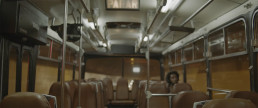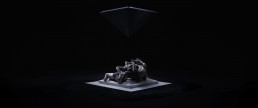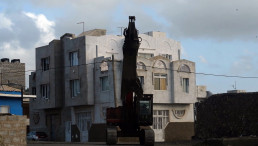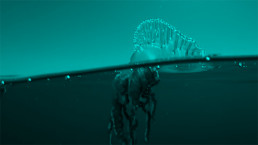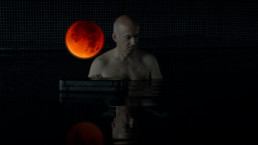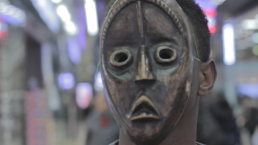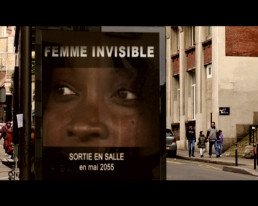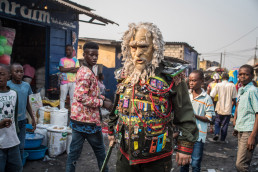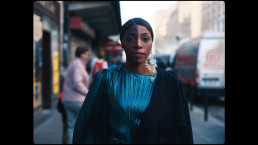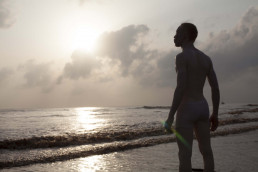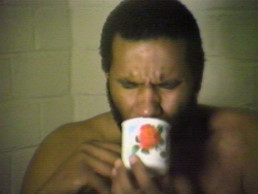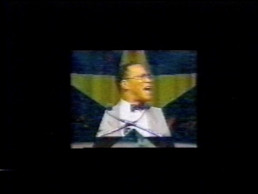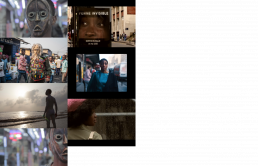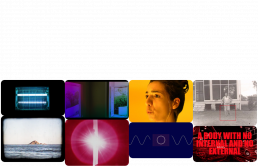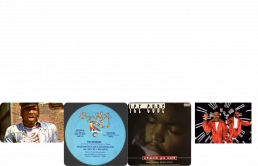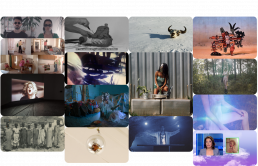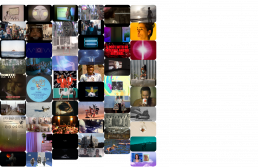“FUSO 2020 – 27 a 30 de Agosto
27 Agosto, 22h00
Open Call
Seleção de Jean-François Chougnet
When you are making video, you’re giving structure to time, which is what a composer does.
Bill Viola
Mais do que nunca, o Open Call do FUSO 2020 revela – no difícil contexto da pandemia – a diversidade das práticas da videoarte feita em Portugal e/ou por artistas portugueses. 176 projetos foram submetidos, o que é mais um sinal da vitalidade da cena contemporânea portuguesa, projetos propostos por jovens artistas, mesmo muito jovens artistas (muitos projetos foram apresentados por artistas nascidos na década de 1990). Voltamos a selecionar um conjunto de obras que surpreendem pela persistência e diversidade de olhares. Este conjunto de filmes mostra, de facto, caminhos insólitos e provocadores, e desafia as nossas perceções sobre a videoarte. O programa de 17 obras favoreceu imagens nómadas e poéticos. As três sessões virtuais têm a ambição de sugerir uma reflexão sobre o estado das imagens hoje, tentando “compor” uma estrutura do tempo.
SESSÃO I
We Are All On The Same Bus _ Nuno Serrão, 2019, 1’59’’
Estamos todos no mesmo autocarro. Se considerarmos o conceito espaço-tempo de Einstein, acabamos com um objeto onde tudo o que aconteceu e tudo o que irá acontecer, encontra-se compreendido no seu interior. Através dele, somos conduzidos por um veículo, vamos chamar de autocarro, completamente autónomo, que segue numa única direção, para a frente, e possui uma única janela, a traseira. A esse veículo, o astrónomo Arthur Eddington chamou A Seta do Tempo. Esta ideia, embora deprimentemente determinista, é difícil de ignorar perante a já comprovada plasticidade do tempo, mesmo quando consideramos o Princípio da incerteza de Heisenberg, onde o ato de observar algo, altera o seu resultado. Conceito que não invalida um Universo determinista, antes, permite a Interpretação de Muitos Mundos de Hugh Everett, também conhecida como Multiverso.
Créditos
Produção: urbanistas
BIO
“Nuno Serrão é fotógrafo e realizador português, interessado nos diálogos entre a ciência e arte contemporânea. Cada uma das suas imagens considera a forma como a informação é trabalhada, partilhada e percepcionada, enquadrando os seus cenários como micro-narrativas, demonstrando sensibilidade e curiosidade pelo planeta e os seus habitantes.” Kate Simpson, Aesthetica Magazine, 2019
Extraction: The Raft of the Medusa (for interdependence director’s cut) _ Salomé Lamas
7’58’’ 2019
Extraction: The Raft of the Medusa é uma meditação sobre o redesenho maciço da humanidade no planeta e um panfleto distópico no antropoceno.
Extração: A Jangada da Medusa retrata um breve momento de euforia, enquanto os ocupantes à deriva na jangada, esperando e rezando para serem resgatados, parecem vislumbrar uma possibilidade de salvação. Quase podemos ouvir os gritos roucos através dos quais eles tentam chamar a atenção para sua situação desesperada, reunindo uma última gota de força diante do vazio. Esta é sua última chance de sobrevivência.
Extração: A Jangada da Medusa refere-se ao paradigma colonial, visão de mundo e tecnologias que marcam regiões de alta biodiversidade, a fim de reduzir a vida à sua conversão em um recurso através do capitalismo, com um enorme impacto ambiental e social.
É uma alegoria para estados de emergência em política ambiental, clima e migração, com um objetivo ético-político.
Créditos
Produção: ART for The World, ONG associada com a UNDPI
Mecenato: United Nations, World Meteorological Organization
Apoio financeiro: SDC – Swiss Agency for Development and Cooperation
Parceria: Gail (India) Limited, ITIC – Ethical Fashion Initiative
Contribuição: République et canton de Genève, Fondazione CARIPLO, Sesc, EBU – Operating Eurovision and Euroradio.
Créditos Lamaland adicionais à comissão:
Apoio ao desenvolvimento: Yaddo, Atelier – Museu Julio Pomar, Fundação Oriente
Apoio: ICA – Instituto do Cinema e Audiovisual, Fundação Calouste Gulbenkian, Grupo Nova Imagem, Bikini Additional support: Fundacíon Botín, Câmara Municipal de Lisboa – Lisbon Film Commission, Screen Miguel Nabinho, Forum Dança, Museu Nacional de História Natural e da Ciência, cE3c – Center for Ecology, Evolution and Environmental Changes, Alexandra Moura, CCB – Centro Cultural de Belém, Silva Dias – Socieda de de Comércio de Lenhas e Carvão, EDM – Empresa de Desenvolvimento Mineiro, RNTRANS – Grupo Urbanos, António e Luciano Neto Décor – Artes Décor e Cenografia, INTERSECCIÓN – Contemporary Audiovisual Art Festival, Estraperlo Editora, Fundación Luís Seoane and Deputación da Coruña
BIO
Salomé Lamas (Lisboa) estudou cinema em Lisboa e Praga, artes visuais em Amsterdão e é doutoranda em arte contemporânea em Coimbra.
O seu trabalho tem sido exibido tanto em contextos artísticos como em festivais de cinema tais como Berlinale, BAFICI, Museo Arte Reina Sofia, FIAC, MNAC – Museu do Chiado, DocLisboa, Cinéma du Réel, Visions du Réel, MoMA – Museum of Modern Art, Museo Guggenheim Bilbao, Harvard Film Archive, Museum of Moving Images NY, Jewish Museum NY, Fid Marseille, Arsenal Institut fur film und videokunst, Viennale, Culturgest, CCB – Centro Cultural de Belém, Hong Kong FF, Museu Serralves, Tate Modern, CPH: DOX, Centre d’Art Contemporain de Genève, Bozar, Louvre, Tabakalera, ICA London, TBA 21 Foundation, Mostra de São Paulo, CAC Vilnius, MALBA, FAEMA, SESC São Paulo, MAAT, La Biennale di Venezia Architettura, entre outros.
Lamas recebeu diversas bolsas, tais como Gardner Film Study Center Fellowship – Harvard University, Film Study Center-Harvard Fellowship, The Rockefeller Foundation – Bellagio Center, Brown Foundation – Dora Maar House, Fundación Botín, Fundação Calouste Gulbenkian, Sundance, Bogliasco Foundation, The MacDowell Colony, Yaddo, Camargo Foundation, Berliner Künstlerprogramm des DAAD.
Colabora com a Universidade Católica do Porto e à Elias Querejeta Zine Eskola. Colabora com a produtora O Som e a Fúria e é representada pela Galeria Miguel Nabinho e pela Kubikgallery.
Honey I’m home – said the Ghost _ Miguel Tavares
7’30’’, 2020
Canção de amor virtual para alguém ouvir, quando online.
Créditos
Produção: Simulacro
BIO
Miguel Tavares (1992) nasceu em Setúbal, onde desde os 3 anos de idade começou a mexer no leitor VHS dos pais. Partilha o seu trabalho entre a instalação de vídeo e a sala de cinema. Desde 2015 tem presença activa nos festivais de cinema nacionais (como IndieLisboa, Porto/Post/Doc, Curtas de Vila do Conde). Completou os estudos no Ar.Co entre 2012 e 2017, onde frequentou o curso Cinema/Imagem em Movimento e o Curso Avançado de Artes Plásticas. Actualmente é professor no departamento de Cinema da mesma escola. É co-fundador do colectivo Simulacro. Para além de realizar, trabalha nas mais variadas áreas em filmes de outros realizadores, destacando o filme Cavalo Dinheiro (2014) de Pedro Costa onde foi assistente de montagem.
Metalheart _ Welket Bungué
7’, 2020
Um corpo cheio de marcas do passado, cicatriza mágoas do passado e esconde perdas vivas. Aqui pulsa um coração invulnerabilizado pelo ruído, ferro e torção. Hoje as nossas fronteiras estão mais limitadas do que nunca. Quem são os confinados/as, quem decide quem pode entrar e fazer parte ou não?! Devemos lidar com a migração como se fosse um cadáver envenenando a nossa mansuetude, ou é uma pergunta real que o capitalismo imperialista ocidental evita a todo o custo responder? A questão é: você está disposto/a a encarar esta premissa (anti)ética?
Créditos
Criação: Welket Bungué
Produção: Kussa Productions, Welket Bungué
Agradecimentos: Kristin Bethge, Stephan Curry
Seleção Oficial XXIV AFRIKA Filmfestival – YAFMA COMPETITION (Bélgica, Outubro 2020)
BIO
Welket Bungué é de etnia balanta, nasceu em Xitole (Guiné-Bissau) a 7 de Fevereiro de 1988, é ator e realizador guineense-português. É licenciado em Teatro no ramo de Atores (ESTC/Lisboa) e pós-graduado em Performance (UniRio/RJ). É Membro Permanente da Academia Portuguesa de Cinema desde 2015, e membro da Deutsche Filmakademie desde 2020. Em 2012 foi distinguido com “Prémio de Melhor Ator” pela sua interpretação em ‘Mütter’. Em 2019 produziu mais de seis curtas-metragens tais como ‘Intervenção Jah’, ‘É Bom Te Conhecer’ ou ‘Corre Quem Pode, Dança quem Aguenta’ e os seus filmes têm circulado internacionalmente por inúmeros festivais de cinema tais como o Africlap (França), Zanzibar Intl. Film Fest., Afrikamera (Berlim), IndieLisboa, DocLisboa, Fest. Intl. de Cinema do Rio de Janeiro ou o Stockholm Dansfilmfestival. Welket realizou as curtas-metragens ‘Eu Não Sou Pilatus'(2019), ‘Arriaga'(2019) e ‘Bastien’(2016) no qual foi distinguido com os prémios “Melhor Ator” e “Melhor Primeira Obra” nos prémios Shortcutz 2017 em Viseu e Ovar respetivamente. Ainda em 2019 foi distinguido com o prémio “Angela Award – On The Road” no Subtitle Festival em Kilkenny, na Irlanda. Em 2020 Welket é o protagonista de ‘Berlin Alexanderplatz’ (Comp. Intl. Berlinale 2020), realizado por Burhan Qurbani, em que a sua interpretação lhe valeu uma indicação ao Urso de Prata e uma nomeação como “Melhor Ator Principal” nos prémios LOLA da Academia Alemã de Cinema (Deutscher Filmpreis). É co-fundador da produtora KUSSA, faz locução para entidades internacionais, desenvolve Escrita Dramática, Argumento de Cinema, Performances e Teatro. Atualmente vive em Berlim.
www.fb.com/welketbungueofficial
www.instagram.com/welket_bungue
Shall We Dance _ Paulo Arraiano
3’29’’, 2020
Em um contexto contemporâneo que alguns podem chamar de 4ª revolução (Klaus Schwab), referindo-se a um novo paradigma digital e a transição apontam para um momento no tempo com presença de superinteligência, IA despertando; Revolução do DNA, biotecnologia; nanotecnologia e outros elementos que transformarão a sociedade e a realidade como a conhecemos, podemos chegar a um lugar em que decidiremos o que é máquina e o que é humano. Passando a realidade, estamos vivendo uma era de uma mudança exponencial tecnológica e biológica e uma nova revolução sensorial.
Apesar de uma perspetiva utópica ou distópica, estamos diante da ideia do antropoceno, idade geológica atual, vista como o período durante o qual a atividade humana tem sido a influência dominante nas mudanças de clima e ambiente em direção à superfície da terra e oceanos, nossa pegada de carbono cria radicais mudanças das Alterações Climáticas.
Apesar de ainda estarmos focados em uma visão antropocêntrica de nosso próprio mundo e buscando uma fuga tecnológica e científica, nosso corpo e a paisagem como um playground para átomos e moléculas se transformarão nos tempos atuais em um novo paradigma físico e até espiritual, com a possibilidade de existência de novas espécies híbridas ou máquinas biológicas com inteligência aumentada cognitiva. A possibilidade de clones, hologramas; e diferentes tipos de formas de vida e dados que criam perguntas sobre a percepção do que é realmente real. Um momento em que o solo, as plantas, os animais e a humanidade se tornam dados imortais…
Em relação aos estudos recentes, se os cientistas desenhassem uma enorme árvore genealógica para todos os animais da Terra, o galho mais antigo pertenceria à água-viva (medusa). Esta forma simples tem cerca de 95% de água e tem sobrevivido, devido à sua simplicidade até agora por oposição da humanidade, com um grau extremo de complexidade.
BIO
Paulo Arraiano (n. 1977, Portugal) conta com inúmeras exposições, individuais e coletivas, nacionais e internacionais, das quais se destacam Dimora Ártica (Milão), Hawaii-Lisbon (Lisboa), Pivô (S. Paulo), Museu d’Història de Catalunya (Barcelona), Hangar (Lisboa), Art Rotterdam (Roterdão), Cidade das Artes Museum (Rio de Janeiro), MAH Museum (Açores), Quartier Général, Centre d’art Contemporain (La Chaux-de-Fonds), Aeroplastics Contemporary (Bruxelas), Petra Gut Contemporary (Zurique), TAL Gallery (Rio de Janeiro), ArtRio (Rio de Janeiro), The Dot Project (Londres), Palácio da Pena (Sintra), Forty/Forty (Varsóvia), Galeria Graphos (Rio De Janeiro), Museu do Côa (V. N. de Foz Côa), ArtWhino (Washington DC), Hifa, Harare International Festival Of Art (Zimbabwe), Câmara Municipal do Porto (Porto), Musée d’Art Moderne (Luxembourg), Scope/Miami Basel (Miami), National Building Museum (Washington DC), P28 (Lisboa), entre outras. Participou em programas de residência e festivais como Transforma (Torres Vedras), Walk&Talk (Açores), LAC (Lagos), Atemporal (Rio de Janeiro), entre outros. Os seus trabalhos estão representados em várias coleções públicas incluindo o Museu CAC Málaga (Spain), Luciano Benton Collection (Italy), Quartier-Général Arts Center (Switzerland), Museu de Angra do Heroísmo (Azores), Sztuki Zewnetrznej Foundation (Polónia), Grupo Pestana (Portugal), Fundação D. Luís/Bairro dos Museus (Portugal), MARCC (Portugal) e inúmeras coleções privadas. Paulo Arraiano licenciou-se em Comunicação pelo ISCEM (Lisboa) e frequentou Artes Plásticas na Ar.Co – Centro de Arte e Visual (Lisboa). É também co-fundador da re_act contemporary, laboratório e programa de residência [Açores] e no.stereo, artist-run platform.
BLOOD MOON _ António Olaio
4’06’’, 2020
Vídeo-performance a partir de filmagens não utilizadas quando fiz uma figuração para um filme e me pediram para improvisar… A monocromia negra da piscina isola o meu corpo como que em suspenso… Na água como se no Espaço… Juntar uma lua vermelha, lua de sangue, ajuda ao artifício de lugar algum… Ficção científica a baixa altitude. Lost. How can I be lost? / Facing my own door / Stepping on my ground? Far, far away from me / As far as I can see / I can be born again / There / In the highest hill / Where the wolves stand still / Just waiting for me / I can rise again / Taller than I am/ There / I’ll sit on a stone / Pretend to be alone / I’ll look at the sky and cry
Créditos
Realização, Produção e Montagem: António Olaio
Direção de Fotografia: Paulo Castilho
Assistente de Câmara: Leandro Silva
Letra, Música e Voz: António Olaio
Música: Haarvöl (Fernando José Pereira, João Faria, Rui Manuel Vieira)
BIO
António Olaio, 1963, Lubango, Angola. Diretor do Colégio das Artes da Universidade de Coimbra. As suas performances dos anos 80 levaram-no à música, num percurso onde a utilização de vários meios (pintura, desenho, vídeo, música) decorre duma forte relação com a performance.
Exposições individuais depois de 2000 (seleção): João, also known as James, also known as Steve, also known as Franz, also known as Boris, Kubikulo, galeria Kubik, Porto; Desterrado, galeria Ala da Frente, Famalicão; Sleeping Beauty, Casa das Artes, Porto; 2019 – What do you think you’re drawing?, Centro das Artes de Águeda; Next Stop is Yesterday, Galeria Municipal de Leiria; 2018 – Cleaning up the Vacuum – Prelude, Gabinete Edições, Lisboa; 2017 – Cleaning up the Vacuum, Galeria Fernando Santos, Porto; 2016 – Young people thinking about each other – Cabeças em trânsito, Galeria João Esteves de Oliveira, Lisboa; 2015 – Heading West, Appleton Square, Lisboa; 2013 – The sorrows of electricity, Filomena Soares, Lisboa; 2012 – Square feet, Círculo de Artes Plásticas de Coimbra; 2011 – This widow is blocking my Windows, Museu do Chiado, Lisboa; 2010 – La Prospettiva is sucking reality, Museu do Neo-Realismo, Vila Franca de Xira; Na cátedra de S. Pedro, Museu Grão Vasco, Viseu; 2009 – La prospettiva, Mario Mauroner, Viena; Brrrrain, Culturgest, Lisboa; Crying my brains out, Filomena Soares, Lisboa; 2007 – I think differently now that I can paint, Centro Cultural Vila Flor, Guimarães; 2005 – Pictures are not movies, Filomena Soares, Lisboa; 2004 – 40 years in a plane, Kenny Schachter conTEMPorary, Nova Iorque. 2002 – Telepathic agriculture, Galerie Schuster, Berlin e Frankfurt; 2001 – Foggy Days in Old Manhattan, Filomena Soares, Lisboa.
A Soul in the Eye – Rosa Spaliviero, 33’
Através de vozes Africanas e da Diáspora, este programa introduz questões como exclusão e discriminação, do ponto de vista do pan-Africanismo. Abordando o racismo, a cor da pele ou a invisibilidade do corpo, o programa chama-nos a atenção para estes assuntos prementes, ao mesmo tempo que explora formas e narrativas não-convencionais.
Partindo da atrocidade que foi a colonização e as marcas que deixou na sua passagem, o programa reflecte sobre a discriminação e o estigma. Numa sociedade global construída sobre a exploração do “outro”, os estereótipos da supremacia ainda prevalecem, numa violência que é permanentemente repetida, de cada vez que o “outro” é invocado.
Numa trajetória comum em direção à igualdade e aceitação do “eu” e do “outro”, o programa aborda a discriminação que prevalece nas nossas sociedades. O título A Soul in the Eye é inspirado no trabalho pioneiro de Zozimo Bulbul, que encena o corpo em luta, em busca da liberdade, de forma a existir com dignidade. Para lá de toda a discriminação e violência (escravatura, colonização, capitalismo), o corpo estigmatizado e silenciado incorpora e possui uma alma.
A maior parte dos vídeos enfatizam a negociação entre o corpo e o espaço social. Partindo da perspetiva histórica e distópica de Kinshasa, abordando questões sobre raça na África dos nossos dias, e passando pela deambulação de corpos negros em espaço urbanos ocidentais, a seleção dá voz à ideia de que o corpo é o centro de gravidade do qual emanam a energia e um sentido de comunidade.
Os artistas usam dispositivos performáticos para pôr em perspetiva uma definição do que somos e de como estamos no mundo: uma busca emocional pela sobrevivência e pela beleza, que leve em consideração todas as contradições e a violência nas nossas sociedades. Como podem os corpos estigmatizados ou apagados existir face à injustiça, à desigualdade e ao racismo?
Os artistas relacionam estas questões com a ação dos corpos, que encenam a reinvenção, a regeneração, resiliência, auto-afirmação ou a perca de identidade. Enquanto ouvimos poemas e murmúrios e vemos olhos e espelhos, colocam-se máscaras nas caras numa procura de reconhecimento e identidade. O corpo – ou a sua representação – reinventa-se constantemente de forma a ser o catalizador de alterações na perceção. Haverá alguma distinção entre identidade e alteridade? Não há resposta possível, só uma viagem cinemática através de trabalhos híbridos de artistas talentosos, de África e da Diáspora.
Core Dump: Kinshasa _ Francois Knoetze, 10’, 2018
Core Dump: Kinshasa faz parte de um projeto de maior escala intitulado Core Dump. A série é composta por quatro filmes que exploram a relação entre a tecnologia digital, a cibernética, o colonialismo, e a retoma da ideia encantada de uma Utopia Humanista Não Alinhada. Este capítulo envolve uma lenda urbana Congolesa que ainda persiste – uma Ficção Científica Afro-distópica de terror, inspirada na escrita de Joseph Tonda e na sua exploração da imaginação Congolesa sob o Colonialismo.
BIO
Nascido na Cidade do Cabo, Francois Knoetze é performer, escultor e cineasta. Knoetze traça os ciclos de vida de objetos descartados e explora os pontos de confluência entre histórias materiais e sociais. Integrou várias exposições coletivas e os seus filmes têm sido apresentados em vários festivais, tais como: WNDX Festival of Moving Image 2015 (Prémio do Júri, Melhor Obra Internacional), 17º Paris Festival for Different and Experimental Cinema, e o 32º Kassel Documentary and Video Festival.
Misfit (a visual poetry) _ Karanja Ng’endo
5’, 2018
Uma poesia visual, Misfit explora questões como raça e colorismo*. O que acontece quando uma pessoa é demasiado negra para ser branca e demasiado branca para ser negra? Uma abordagem experimental ao albinismo e ao colorismo na comunidade Negra.
*Colorismo consiste na classificação de pessoas negras a partir do tom de pele.
BIO
Cineasta Queniano nascido e criado em Nairobi, Karanja subscreve uma abordagem “fá-los rir, fá-los chorar” no cinema. Prefere que a audiência tenha uma reação emocional às histórias que conta. A sua primeira curta-metragem, Misfit, foi premiada com o Silver Dhow Award, Zanzibar International Film Festival. Completou, recentemente, a sua segunda curta-metragem, Naisula. Esteve em residência na Film Residency International Class, na FilmAkademie Baden-Württemberg. É bolseiro do One World Media 2020 Fellowship.
Versus _ Philbert Aimé Mbabazi Sharangabo
7’, 2016
Sozinho numa cidade Europeia, um jovem negro mergulha nos recônditos sombrios da sua mente e das suas memórias, num confronto consigo mesmo.
BIO
Philbert Aimé Mbabazi Sharangabo graduou-se em 2017 na Haute École d’Art et de Design, em Genebra, no Departamento de Cinema. O seu filme mais recente, a curta I Got My Things And Left foi galardoada com o Grande Prémio do Oberhausen International Short Film Festival, em 2019. Mbabazi encontra-se presentemente a escrever a sua primeira longa-metragem, Spectrum, que decorre em Genebra. O Oberhausen International Short Film Festival programou, para este ano, uma retrospetiva do seu trabalho. Mbabazi Sharangabo vive entre a Suíça e o Rwanda. É director da Imitana Productions, uma produtora sediada no Rwanda, que produz o seu trabalho e o de outros jovens cineastas da vibrante cena artística de Kigali.
Versus _ Philbert Aimé Mbabazi Sharangabo
7’, 2016
Sozinho numa cidade Europeia, um jovem negro mergulha nos recônditos sombrios da sua mente e das suas memórias, num confronto consigo mesmo.
BIO
Philbert Aimé Mbabazi Sharangabo graduou-se em 2017 na Haute École d’Art et de Design, em Genebra, no Departamento de Cinema. O seu filme mais recente, a curta I Got My Things And Left foi galardoada com o Grande Prémio do Oberhausen International Short Film Festival, em 2019. Mbabazi encontra-se presentemente a escrever a sua primeira longa-metragem, Spectrum, que decorre em Genebra. O Oberhausen International Short Film Festival programou, para este ano, uma retrospetiva do seu trabalho. Mbabazi Sharangabo vive entre a Suíça e o Rwanda. É director da Imitana Productions, uma produtora sediada no Rwanda, que produz o seu trabalho e o de outros jovens cineastas da vibrante cena artística de Kigali.
The invisible woman _ Pascale Obolo
6’, 2008
Uma jovem mulher negra tenta vislumbrar caras de pessoas da sua comunidade no cinema Francês. Questiona, desta forma, a presença do corpo negro e a sua invisibilidade no espaço público. Esta busca obsessiva levá-la-á ao limiar da loucura.
BIO
Pascale Obolo é realizadora independente, ativista, e curadora. Nascida nos Camarões, estudou cinema em Paris. Enquanto cineasta feminista e ativista, o seu trabalho coloca em questão as memórias, e é dedicado a temas como identidade, exílio, e invisibilidade. O seu filme Calypso Rose: Lioness of the Jungle ganhou o Silver Yennega Prize no Fespaco 2013, em Ouagadougou, Burkina Faso. O seu trabalho mais recente parte do escrutínio de arquivos para a construção de narrativas históricas, a partir de uma perspetiva pós-colonial. Pascale Obolo é fundadora de Afrikadaa, uma revista de arte contemporânea Africana. Também é diretora da African Art Book Fair (AABF).
Never Look At the Sun _ Baloji
5’, 2020
Tradições ancestrais, combinadas com preconceitos modernos e estigma, explicam o branqueamento da pele.
BIO
Baloji é um artista em movimento, músico, poeta, cineasta, um homem das imagens e das ideias. Baloji significa “homem da ciência” em Swahili, mas, durante o período colonial, esse significado foi-se alterando, devido à evangelização cristã, para “homem das ciências ocultas” e, mais tarde, “feiticeiro”. Baloji nasceu em Lubumbashi, República Democrática do Congo, mas cresceu na Bélgica. Quando era teenager criou o seu primeiro coletivo rap, Starflam. Em 2008, lançou, em nome próprio, Hotel Impala, um álbum concebido como resposta a uma carta que recebeu da sua mãe, após 25 anos ausência. Baloji dirige os seus próprios vídeos e concebe a imagem dos seus vários projetos.
Rosa Spaliviero (nascida em 1981 em Dakar, Senegal) vive e trabalha entre Bruxelas e Lubumbashi. Enquanto programadora assistente, entre 2006 e 2010, do Dockanema Festival do Filme Documentário, no Maputo, dirigido por Pedro Pimenta, ficou a conhecer as cinematografias Africanas. Como programadora freelancer tem vindo a coordenar eventos culturais e a comissariar programas de cinema em Bruxelas, Veneza, Dakar, Zurique, Paris, Maputo e Lubumbashi. Foi, ao longo de sete anos (2011-2018), produtora no Atelier Graphoui, um espaço para a produção audiovisual experimental em Bruxelas, que apoia as primeiras-obras de jovens realizadores. Em 2017 fundou a produtora de cinema independente Twenty Nine Studio & Production, em Bruxelas. Colabora frequentemente com Katy Lena Ndiaye na IndigooMoodFilms, baseada simultaneamente em Dakar e em Bruxelas. Foi uma das fundadoras de Picha asbl, e está envolvida com a Bienal de Lubumbashi desde 2008, enquanto diretora de produção e programadora de cinema. A Bienal é um ponto de encontro da jovem cena artística da República Democrática do Congo.
Ulysses Jenkins: Notions of Freedom, Lory Zippay, 40’
Baseado em Los Angeles, o artista Ulysses Jenkins tem vindo a trabalhar, ao longo de cinco décadas, em performance, vídeo e multimédia, e a sua arte transmite-nos uma urgência que é extremamente relevante nos dias de hoje. Usando a tecnologia como ferramenta para fomentar a comunicação e consolidar os laços comunitários, Jenkins defende que devemos apropriar-nos dos media, de forma a criar e a transmitir representações e histórias alternativas da experiência Afro-Americana. Assumindo o papel de um auto-denominado “video-griot”, Jenkins inspira-se na tradição oral Africana de contar histórias para criar vídeos que juntam música, imagens de arquivo e dos mass media, imagética gravada, performance, e narrativa poética.
Começando a sua carreira artística como muralista, Jenkins fundou o pioneiro coletivo Video Venice News, no início dos anos 1970. O coletivo é talvez mais conhecido pelo seu trabalho Remnants of the Watts Festival (1972-73), um video verité, que Jenkins descreve como “um documentário de um tempo e de um lugar” – o dos lendários festivais que celebravam a cultura negra e a comunidade. O envolvimento de Jenkins em práticas artísticas baseadas na comunidade levou-o ao ensino; entre 1970 e 1972 ensinou arte a jovens em liberdade condicional, no Los Angeles County Probation Department, e em 1989 ensinou vídeo num programa de intervenção para gangs, em São Francisco.
A colaboração é uma questão central na prática artística de Jenkins. Participante ativo na cena artística Californiana desde 1960, colaborou em performances de cunho político, ações ritualísticas e experimentação com tecnologias, com artistas como Kerry James Marshall, Studio Z (com David Hammons, Senga Nengudi, e Maren Hassinger), Kit Galloway e Sherrie Rabinowitz, entre muitos outros, e fez música e spoken word com o seu grupo multimédia conceptual The Othervisions Art Band.
Nas décadas de 1980 e 1990, Jenkins foi inovador na exploração do potencial criativo das tecnologias emergentes, pré-Internet. Concebendo performances com “videophone”, para o que designava como “contextos rituais contemporâneos”, Jenkins promoveu a participação da audiência e o intercâmbio interativo como forma de efetuar uma mudança social.
Jenkins regressou muitas vezes ao tema do burlesco no seu trabalho. Definido como poesia que é “irregular no ritmo e na rima”, o burlesco torna-se, para o artista, numa potente metáfora e, simultaneamente, em estratégia artística. Referindo-se a este termo numa entrevista dada em 2008, afirma: “…É isto que é ser negro na sociedade. Por vezes as coisas são imprevisíveis, e é difícil perceber o que está a passar-se. E então disse para mim mesmo ‘É isto que vou fazer.’ Há Dada e Surrealismo, e eu vou criar o “Burlequismo”, e desde aí tem havido sempre elementos do burlesco no meu trabalho.”
Este programa é composto por uma seleção do corpo de trabalho em vídeo mais importante, mas pouco reconhecido, de Ulysses Jenkins.
Inconsequential Doggereal _ Ulysses Jenkins, 15’13’’, 1981
Jenkins mescla fragmentos, registados por ele, e narrativa poética, com momentos retirados da ininterrupta corrente de notícias, publicidade e entretenimento da televisão. As imagens e sons recolhidos são editados com efeitos como jamming, freeze-frame, loops, sobreposições, e misturados com clips de documentários científicos, filmes passados na TV, comentários nos telejornais vespertinos, e uma entrevista com o ator Peter Sellers. A estas imagens e sons Jenkins justapõe várias situações reais; jogos de futebol a correr mal, um jovem casal em casa, e o próprio artista deitado num quintal verde, suburbano, enquanto um cortador de relva gira perigosamente à volta do seu corpo.
Música: “Contextures: riots decades 60s”, de William Craft.
Imagem: Paul Best, Ulysses Jenkins.
Performers: Paul Best, Sheila Broyles, Linda Camillo, Lydia Elliot, Ulysses Jenkins, Robin King, Artur Matuck, Dale Menagh, Karen Westerfield, e Cynthia Williams. Media Center UCSD, Bill Jennings, Jim Rix. Mid-ocean production pieces, Sherman George. Produzido e Editado por Ulysses Jenkins.
Secrecy: “Help Me to Understand” _ Ulysses Jenkins, 8’, 1994
Jenkins escreve: “O título é inspirado na utilização, pelo videasta, da tradição Africana de ‘Secretismo’, uma arte que esconde e revela. Ou, por outras palavras; aquilo que está à nossa frente (circunstâncias ou objetos artísticos/rituais) pode permanecer indiscernível se não conseguirmos descodificar a linguagem metafórica utilizada. A intenção deste trabalho é examinar como a discriminação é ritualizada nos meios de comunicação.” Jenkins faz uma colagem de imagens raciais estereotipadas de homens negros, tiradas de filmes, televisão, entretenimento, e desportos, sempre pontuada pela pergunta: “Ajuda-me a compreender / o que é que se está a passar?”
Editado por Ulysses Jenkins.
Pós produção: Bay Area Video Coalition, San Francisco, CA. © 1994, Othervisions Studio.
Notions of Freedom _ Ulysses Jenkins, 15’47’’, 2007
Jenkins traça a história do Jazz – que ele considera “a primeira expressão artística verdadeiramente Americana” – desde a sua origem em Nova Orleães e no Sul Americano, passando pelos clássicos de Louis Armstrong e Duke Ellington, até às grandes inovações introduzidas por Ornette Coleman, Sun Ra e Miles Davis. Numa densa colagem de imagens de Martin Luther King Jr., manifestações, e Malcom X, Jenkins estabelece uma relação direta do desenvolvimento do Jazz com o Movimento dos Direitos Civis Norte-Americano. Utilizando tecnologia de captura de movimento (mocap), vemos imagens de figuras que dançam, sobrepostas às imagens de arquivo. Os bailarinos exercem uma influência poderosa sobre a documentação histórica, pois os seus movimentos atravessam o tempo e projetam-se no futuro.
Bailarinos: Cheryl Banks-Smith, Ulysses Jenkins.
Motion Capture e Animação: Mugen Suzuki.
Banda Sonora: ”Chief Concern”, de Kei Akagi, com Bobby Rodriguez (trompete), Charles Owens (saxofone), Jinshi Ozaki (guitarra elétrica), Kei Akagi (keyboards), Chris Colangelo (baixo), Jason Harnell (bateria), Norm Beede (djembé).
Agradecimentos especiais: Lisa Naugle, Dance Department Motion Capture Lab, University of California, Irvine; Ross Whitney, Music Department Recording Engineer na University of California, Irvine.
BIO
Ulysses Jenkins nasceu em 1946, em Los Angeles, onde vive presentemente. Licenciou-se na Southern University e graduou-se no Otis Art Institute. É Professor Associado na Claire Trevor School of the Arts, e Professor Afiliado no programa de African American Studies, na University of California, Irvine. Recebeu bolsas do The National Endowment for the Arts, e foi contemplado com o Primeiro Prémio em Vídeo Experimental pelo Black Filmmakers Hall of Fame, em 1990 e 1992. O seu trabalho tem sido apresentado regularmente em exposições, destacando-se: America is Hard to See (2015), Whitney Museum of American Art; Now Dig this!: Art and Black Los Angeles 1960-1980 (2012), Hammer Museum; VideoStudio: Playback, The Studio Museum in Harlem (2011); e California Video (2008) no J. Paul Getty Museum.
–
Lori Zippay é uma curadora, escritora e consultora baseada em Nova-Iorque, ativa na organização de exposições de media art e na distribuição e na preservação deste medium, há mais de trinta e cinco anos. Desde meados dos anos 80 até 2019 foi Diretora Executiva da Electronic Arts Intermix (EAI), uma associação sem fins lucrativos, e um dos mais importantes repositórios de media art. Zippay construiu o arquivo, que conta com mais de 4000 obras de media art, tendo também iniciado um programa pioneiro de preservação das obras em suporte videográfico. Foi co-autora e inaugurou a extensa plataforma de publicações online e de recursos digitais, e estabeleceu vários projetos e programas artísticos de longo alcance. Comissariou um grande número de exposições de media art e de programação em vídeo; dá regularmente palestras em instituições culturais e participa em conferências em todo o mundo, das quais destaca as do The Museum of Modern Art, Nova-Iorque; Tate Modern, Londres; e Centro Georges Pompidou, em Paris. Escreve regularmente sobre media art, tendo desenvolvido e sido consultora em projetos de curadoria, de preservação e de projetos educativos com jovens artistas ou artistas estabelecidos. Participou em júris de festivais internacionais, em comissões para atribuição de financiamento, em simpósios e em painéis de consultores. Presentemente, enquanto Diretora Emérita da EAI, participa nos Conselhos Consultivos da Times Square Arts, e, também, no Collaborative Cataloging Japan.
“FUSO 2020 – August 27th to 30th
August 27th, 10pm.
Open Call
Selection of Jean-François Chougnet
When you are making video, you’re giving structure to time, which is what a composer does.
Bill Viola
The Open Call of FUSO 2020 once again reveals – in the tricky context of the pandemic – the diversity of videoart practices made in Portugal and/or by Portuguese artists. 176 projects were submitted, which is a strong signal of the vitality of the Portuguese contemporary scene. Young artists, even very young artists – born in the 1990s – have submitted projects of a great strength and originality. We select a set of works that surprise by the persistence and diversity of looks. The program of 17 works show nomadic and poetic images. The online sessions offer a reflection on the status of images today, trying to “compose” a structure of time.
SESSION I
We Are All On The Same Bus _ Nuno Serrão, 2019, 1’59’’
We are all on the same bus. If we consider Einstein’s concept of space-time, we end up with an object in which everything that happens and everything that will happen is contained in its interior. Through it, we are driven by a vehicle, we will call it a bus, which is completely autonomous, which goes in a single direction, forward, and has a single window, the back window. The astronomer Arthur Eddington called this vehicle The Arrow of Time. This idea, although depressingly determinist, is difficult to ignore given the already proven plasticity of time, even when we consider Heisenberg’s Principle of Uncertainty, in which the act of observing something alters its result. A concept which does not invalidate a deterministic Universe, but rather allows for Hugh Everett’s Many-worlds Interpretation, also known as the Multiverse.
Credits
Production: urbanistas
BIO
“Nuno Serrão is a Portuguese photographer, filmmaker, and creative director, interested in the dialogues between science and contemporary art. Each of his images considers how information is handled, shared and perceived, framing scenarios as micro-narratives, demonstrating a sensitivity and a curiosity for the planet and its inhabitants.” Kate Simpson, Aesthetica Magazine, 2019.
Extraction: The Raft of the Medusa (for interdependence director’s cut) _ Salomé Lamas
7’58’’ 2019
Extraction: The Raft of the Medusa is a meditation on humanity’s massive redesign of the planet and a dystopic pamphlet on the anthropocene.
It portrays a brief moment of euphoria as the drifting occupants on the raft, hoping and praying to be rescued, appear to glimpse a possibility of salvation. We can almost hear the hoarse cries through which they attempt to draw attention to their desperate plight, mustering a final ounce of strength before the void. This is their last chance of survival.
Extraction: The Raft of the Medusa refers to the colonial paradigm, worldview, and technologies that mark out regions of high biodiversity in order to reduce life to its conversion into a resource through capitalism, with an enormous environmental and social impact.
It is an allegory for states of emergency in environmental policy, climate and migration, with an ethical- political purpose.
Credits
Production: ART for The World, ONG associated with the UNDPI
Patronage: United Nations, World Meteorological Organization
Financial support: SDC – Swiss Agency for Development and Cooperation
Partnership: Gail (India) Limited, ITIC – Ethical Fashion Initiative
Contribution: République et canton de Genève, Fondazione CARIPLO, Sesc, EBU – Operating Eurovision and Euroradio.
Lamaland additional credits to the commission:
Development support: Yaddo, Atelier – Museu Julio Pomar, Fundação Oriente
Support: ICA – Instituto do Cinema e Audiovisual, Fundação Calouste Gulbenkian, Grupo Nova Imagem, Bikini Additional support: Fundacíon Botín, Câmara Municipal de Lisboa – Lisbon Film Commission, Screen Miguel Nabinho, Forum Dança, Museu Nacional de História Natural e da Ciência, cE3c – Center for Ecology, Evolution and Environmental Changes, Alexandra Moura, CCB – Centro Cultural de Belém, Silva Dias – Socieda de de Comércio de Lenhas e Carvão, EDM – Empresa de Desenvolvimento Mineiro, RNTRANS – Grupo Urbanos, António e Luciano Neto Décor – Artes Décor e Cenografia, INTERSECCIÓN – Contemporary Audiovisual Art Festival, Estraperlo Editora, Fundación Luís Seoane and Deputación da Coruña
BIO
Salomé Lamas (Lisbon) studied cinema in Lisbon and Prague, visual arts in Amsterdam and is a Ph.D candidate in contemporary art studies in Coimbra.
Her work has been screened both in art venues and film festivals such as Berlinale, BAFICI, Museo Arte Reina Sofia, FIAC, MNAC – Museu do Chiado, DocLisboa, Cinema du Réel, Visions du Réel, MoMA – Museum of Modern Art, Museo Guggenheim Bilbao, Harvard Film Archive, Museum of Moving Images NY, Jewish Museum NY, Fid Marseille, Arsenal Institut fur film und videokunst, Viennale, Culturgest, CCB – Centro Cultural de Belém, Hong Kong FF, Museu Serralves, Tate Modern, CPH: DOX, Centre d’Art Contemporain de Genève, Bozar , Tabakalera, ICA London, TBA 21 Foundation, Louvre, Mostra de São Paulo, CAC Vilnius, MALBA, FAEMA, SESC São Paulo, MAAT, La Biennale di Venezia Architettura, among others.
Lamas was granted several fellowships such as the Gardner Film Study Center Fellowship – Harvard University, Film Study Center-Harvard Fellowship, The Rockefeller Foundation – Bellagio Center, Brown Foundation – Dora Maar House, Fundación Botín, Fundação Calouste Gulbenkian, Sundance, Bogliasco Foundation, The MacDowell Colony, Yaddo, Camargo Foundation, Berliner Künstlerprogramm des DAAD.
She collaborates with Universidade Católica Portuguesa and Elias Querejeta Zine Eskola.
She collaborates with the production company O Som e a Fúria and is represented by Galeria Miguel Nabinho and Kubikgallery.
Honey I’m home – said the Ghost _ Miguel Tavares
7’30’’, 2020
A song of virtual love for someone to listen to when online.
Credits
Production: Simulacro
BIO
Miguel Tavares (1992) was born in Setúbal where, from the age of 3, he began to tinker with his parents´ VHS player. He divides his work between video installation and cinema. Since 2015, he has been an active presence at national cinema festivals (such as IndieLisboa, Porto/Post/Doc, Curtas de Vila do Conde). He completed his studies at Ar.Co between 2012 and 2017, where he attended the Cinema/Moving Image Course and the advanced Course in Fine Arts. Currently, he is a professor in the Cinema department at the same school. He is the co-founder of the collective Simulacro. In addition to directing, he works in a variety of areas on films by other directors, a highlight being the film Cavalo Dinheiro (2014) by Pedro Costa, on which he was assistant editor.
Metalheart _ Welket Bungué
7’, 2020
A body full of the marks of the past heals its past hurts and hides living losses. Here beats a heart made invulnerable by noise, iron, and twist. Our boundaries are today tighter than ever. Who are the confined ones, who decide those who can and cannot enter?! Shall we deal with the migration as if it is a dead body poisoning our meekness, or is it a real question that imperial western capitalism doesn’t want to answer? The question is: are you willing to stand and confront this (un)ethical premise?
Credits
Authorship: Welket Bungué
Production: Kussa Productions, Welket Bungué
Acknowledgements: Kristin Bethge, Stephan Curry
XXIV AFRIKA Filmfestival – Official Selection YAFMA COMPETITION (Belgium, October 2020)
BIO
Welket Bungué is originally from the Balanta tribe, and was born in Xitole (Guinea-Bissau) on February 7th, 1988. He is a Portuguese-Guinean actor and film director. He holds a degree in theater from the Actors branch (ESTC / Lisbon) and a postgraduate degree in Performance (UniRio / Brazil). He has been a Permanent Member of the Portuguese Academy of Cinema since 2015, and a member of the Deutsche Filmakademie since 2020. In 2012, he was awarded Best Actor for his performance in Mütter. In 2019, he produced more than six short films such as Jah Intervention, It’s Good To Meet You or Run If You Can, Dance If You Dare, and his films have been screened at several international film festivals such as Africlap (France), Zanzibar Intl. Film Fest., Afrikamera (Berlin), IndieLisboa, DocLisboa, Rio de Janeiro Intl. Film Fest. or Stockholm Dansfilmfestival. He also directed the short films I Am Not Pilatus (2019), Arriaga (2019) and Bastien (2016) for which he was distinguished with the Best Actor Award and Best First Film Award, by the Shortcutz Awards 2017, in Ovar and Viseu (both in Portugal). In 2019, he was awarded with an Angela Award – On The Road’ at the Subtitle Festival in Kilkenny (Ireland), curated by Richard Cook & Steve Cash. In 2020, Welket starred as Franz Biberkopf in Berlin Alexanderplatz (Berlinale 2020), directed by Burhan Qurbani, which earned him a nomination for the Silver Bear and a nomination as Best Male Lead’ at the LOLA awards of the German Film Academy (Deutscher Filmpreis). He is currently based in Berlin.
www.fb.com/welketbungueofficial
www.instagram.com/welket_bungue
Shall We Dance _ Paulo Arraiano
3’29’’, 2020
In a contemporary context that some may call a 4th revolution (Klaus Schwab) referring to a new digital paradigm and transition point to a moment in time with a presence of superintelligence, IA awakening, DNA revolution, biotech, nanotech and other elements that will transform society and reality as we know it, we may arrive at a place where we shall decide what is machine and whats is human. Swiping reality, we are experiencing an age of a technologic and biological exponential change, and a new sensorial revolution.
Beyond a utopian or dystopian perspective, we are facing the idea of the anthropocene, the current geological age, viewed as the period during which human activity has been the dominant influence on climate and environmental changes in the earth’s surface and oceans, our carbon footprint creates radical climate change.
In spite of that, we are still focused on an anthropocentric vision of our own world, and looking to a technological and scientific escape; our body as well as our landscape, a playground for atoms and molecules, will be transformed in the present into a new physical and even spiritual paradigm, with the possibility of the existence of new hybrid species or biologically based machines with cognitive augmented intelligence. The possibility of clones, holograms and different kinds of lifeforms and data that create questions on perceiving what is actually real. A moment where soil, plants, animals and mankind become immortal data…
Coming from water, all living forms were able to grow and survive, procreate and colonise this planet, and transform it. According to recent studies, if scientists were to draw an enormous family tree for all of Earth’s animals, the oldest branch would belong to the jellyfish (medusae). This simple form is made up of around 95% water and, due to its simplicity, has been surviving with an extreme degree of complexity, as opposed to mankind.
BIO
Paulo Arraiano (b. 1977, Portugal) is a visual artist based in Lisbon. He has participated in several exhibitions, both solo and collective, including Dimora Artica (Milan), Hawaii-Lisbon (Lisbon), Pivô (S. Paulo), Museu d’Història de Catalunya (Barcelona), Art Rotterdam (Rotterdam), Hangar (Lisbon), Cidade das Artes Museum (Rio de Janeiro), MAH Museum (Azores), Quartier General, Centre d’art Contemporain (La Chaux-de-Fonds), Aeroplastics Contemporary (Brussels), Petra Gut Contemporary (Zurich), TAL Gallery (Rio de Janeiro), ArtRio (Rio de Janeiro), Pena Palace (Sintra), Galeria Graphos (Rio De Janeiro), Museu do Côa (V. N. de Foz Côa), Hifa, Harare International Festival Of Art (Zimbabwe), Câmara Municipal do Porto (Porto), Museé d’Art Moderne (Luxembourg), Scope/Miami Basel (Miami), National Building Museum (Washington DC), P28 (Lisbon), among others. Paulo Arraiano has also participated in several artist residency programmes, such as Hangar (Lisbon); Walk&Talk (Azores), Transforma (Torres Vedras), LAC (Lagos), among others. He is represented in both public and private collections such as CAC Málaga Museum (Spain), Luciano Benton Collection (Italy), Quartier-General Arts Center (Switzerland), Museu de Angra do Heroísmo (Azores), Sztuki Zewnetrznej Foundation (Poland), Pestana Group (Portugal), Fundação D. Luís/Museum Quarter (Portugal), MARCC Museum (Portugal). Paulo Arraiano has degrees in Communication by ISCEM (Lisbon) and in Visual Arts at Ar.Co – Centro de Arte e Comunicação Visual (Lisbon). He is also a co-founder of re_act contemporary, art laboratory and residence program, based in the Azores Islands, and no.stereo, an independent artist-run platform.
BLOOD MOON _ António Olaio
4’06’’, 2020
Video-performance that uses unused footage of a feature film where I performed as an extra and was allowed to improvise… The monochrome, black swimming pool isolates my body as though it were in suspension… In water as if it were in space… By adding a red moon, a blood moon plays its role in an artifice of the creation of a place, nowhere place nowhere, science fiction at low altitude. Lost. How can I be lost? / Facing my own door / Stepping on my ground? Far, far away from me / As far as I can see / I can be born again / There / In the highest hill / Where the wolves stand still / Just waiting for me / I can rise again / Taller than I am / There / I’ll sit on a stone / Pretend to be alone / I’ll look at the sky and cry
Credits
Direction, Production and Editing: António Olaio
Cinematography: Paulo Castilho
Camera Assistant: Leandro Silva
Lyrics, Music and Voice: António Olaio
Music: Haarvöl (Fernando José Pereira, João Faria, Rui Manuel Vieira)
BIO
António Olaio, 1963, Lubango, Angola. Director of the College of Arts, University of Coimbra. His early performances in the 80’s led him to music. The way he uses different means like painting, drawing, video, music, has a strong connection to performance.
Solo exhibitions after 2000 (a selection): João, also known as James, also known as Steve, also known as Franz, also known as Boris, Kubikulo, Kubik gallery, Porto; Desterrado, Ala da Frente gallery, Famalicão; Sleeping Beauty, Casa das Artes, Porto; 2019 – What do you think you’re drawing?, Centro das Artes de Águeda; Next Stop is Yesterday, Leiria Municipal Gallery; 2018 – Cleaning up the Vacuum – Prelude, Gabinete Edições, Lisbon; 2017 – Cleaning up the Vacuum, Galeria Fernando Santos, Porto; 2016 – Young people thinking about each other – Heads in transit, Galeria João Esteves de Oliveira, Lisbon; 2015 – Heading West, Appleton Square, Lisbon; 2013 – The sorrows of electricity, Filomena Soares, Lisbon; 2012 – Square feet, Círculo de Artes Plásticas, Coimbra; 2011 – This widow is blocking my Windows, Museu do Chiado, Lisbon; 2010 – La Prospettiva is sucking reality, Museu do Neo-Realismo, Vila Franca de Xira; Na cátedra de S. Pedro, Museu Grão Vasco, Viseu; 2009 – La prospettiva, Mario Mauroner, Vienna; Brrrrain, Culturgest, Lisbon; Crying my brains out, Filomena Soares, Lisbon; 2007 – I think differently now that I can paint, Centro Cultural Vila Flor, Guimarães; 2005 – Pictures are not movies, Filomena Soares, Lisbon; 2004 – 40 years in a plane, Kenny Schachter conTEMPorary, New York; 2002 – Telepathic agriculture, Galerie Schuster, Berlin e Frankfurt; 2001 – Foggy Days in Old Manhattan, Filomena Soares, Lisbon.
A Soul in the Eye – Rosa Spaliviero, 33’
Including both diasporic and african voices, this program introduces us to the topics of exclusion and discrimination from the pan-african point of view. Dealing with racism, skin colour or invisibility of the body, it brings attention to these pressing issues, while exploring unconventional forms and narratives.
Starting from the atrocity of colonization and what it leaves behind in its wake, the program reflects on discrimination and stigma. In a global society that is built on the exploitation of the other and yet is still dominated by stereotypes of supremacy, violence is today permanently repeated when evoking the “other”.
As a shared path towards equality and acceptance of «self» and «other», the program questions prevailing discrimination of our societies. The title A Soul In the Eye is inspired by the pioneering work of Zozimo Bulbul, where the struggling body is staged, in search of freedom, in order to exist and to be worthy. Above all the discrimination and violence (enslavement, colonization, capitalism), the muted and stigmatized body embodies and owns a soul.
Most of the videos emphasize a negotiation between the body and the social space. Starting from the historical and dystopian perspective in Kinshasa, touching race issues in Africa today, until the wander of black bodies in western urban spaces; the selection highlights the idea that the body is the centre of gravity from which an energy and a sense of community radiate.
Artists use performative devices that put into perspective the definition of oneself and of being in the world: an emotional quest for survival and beauty, which take into account all the contradictions and violences of our societies. How do stigmatized or invisibilized bodies exist in the face of injustice, inequality and racism?
Artists relate these questions to the action of bodies, in a sense of affabulation, regeneration, resilience, self-affirmation or loss of identity. While hearing poems and whispers, watching eyes and mirrors, the faces put on masks in quest of recognition and identity. The body – or its representation – constantly reinvents itself in order to catalyze a shift in perception. Is there a distinction between identity and otherness? There is no possible answer but a cinematic journey through hybrid works by talented artists from Africa and the diaspora.
Core Dump: Kinshasa _ Francois Knoetze, 10’, 2018
Core Dump: Kinshasa is part of a larger project entitled «Core Dump». The series comprises four films which explore the relationship between digital technology, cybernetics, colonialism and the reenchanted notion of a Non-Aligned Humanist Utopia. This chapter evokes a long-enduring Congolese urban legend – an Afro-dystopian Sci-Fi horror inspired by the writing of Joseph Tonda and his exploration of the Congolese imagination within Colonialism.
BIO
Born in Cape Town, Francois Knoetze is a performance artist, sculptor and filmmaker. Knoetze retraces the life cycles of discarded objects and explores junctures between material and social histories. His work has participated in group exhibitions and has also been shown at a number of festivals, including the WNDX Festival of Moving Image 2015 (winner of the Jury Prize for Best International Work), the 17th Paris Festival for Different and Experimental Cinema, the 32nd Kassel Documentary and Video Festival.
Misfit (a visual poetry) _ Karanja Ng’endo
5’, 2018
An exploration of race and colourism. What happens when a person is too Black to be white and too white to be Black? An experimental look at albinism and colourism in the Black community.
BIO
Kenyan filmmaker born-and-raised in Nairobi, Karanja subscribes to a “make them laugh, make them cry” approach to filmmaking. He wants the audience to have an emotional reaction to the stories he tells. His debut short film Misfit won the Silver Dhow Award at Zanzibar International Film Festival. He has recently completed his second short film Naisula. Lately he attended a film Residency International Class at the FilmAkademie Baden-Wurttemberg and has been selected for the One World Media 2020 Fellowship.
Versus _ Philbert Aimé Mbabazi Sharangabo
7’, 2016
Alone in a European city, a young black man dives into dark corners of his mind and memories, confronting himself.
BIO
Mbabazi Sharangabo Philbert Aimé graduated at Haute École d’Art et de Design in Geneva in the cinema department in 2017. His recent short film I Got My Things And Left won the Grand Prize of the Oberhausen International Short Film Festival in 2019. Mbabazi is currently writing his first feature film Spectrum, set in Geneva. This year, the Oberhausen International Short Film Festival has dedicated a retrospective program of his work. Mbabazi Sharangabo lives between Switzerland and Rwanda. He runs Imitana Productions, a Rwanda based production company, which produces his work and those of the vibrant young filmmakers scene in Kigali.
The invisible woman _ Pascale Obolo
6’, 2008
A young black woman searches for the faces of her community in french cinema. She questions the presence of the black body and its invisibilization in public space. Her obsessive search will lead her to the brink of madness.
BIO
Pascale Obolo is an independent filmmaker, activist, curator. Born in Cameroon, she studied film in Paris. As a feminist and activist filmmaker, her work throws memories into question and is dedicated to the themes of identity, exile, invisibility. Her film Calypso Rose: Lioness of the Jungle won the silver Yennega prize at the Fespaco 2013. Her latest work scrutinises archives through the construction of historical narratives from a postcolonial perspective. Pascale Obolo is the founder of Afrikadaa, a magazine for contemporary African art. She is also director of the African Art Book Fair (AABF).
Never Look At the Sun _ Baloji
5’, 2020
Ancestral patterns combined with modern prejudices and stigma explain skin bleaching.
BIO
Baloji is an artist in motion, a musician, poet, film director, a man of images and ideas. Baloji means “man of science” in Swahili, but during the colonial period, that meaning shifted as a result of Christian evangelisation, to signify “man of the occult sciences” and then “sorcerer”. Baloji was born in Lubumbashi (DRC Congo) and grew up in Belgium. As a teenager, he started his first rap collective, Starflam. In 2008, as Baloji, he released “Hotel Impala” an album conceived as a reply to a letter he received from his mother after a 25-year absence. Baloji directs his own videos and creates the visuals for his varied projects.
Rosa Spaliviero (born in 1981 in Dakar, Senegal) lives and works mainly between Brussels and Lubumbashi. She was introduced to African cinemas in Maputo between 2006 and 2010, as a program assistant at the Dockanema Documentary Film Festival directed by Pedro Pimenta. She has been coordinating cultural events and curating film programs in Brussels, Venice, Dakar, Zurich, Paris, Maputo and Lubumbashi as a freelancer since then. She was producer for Atelier Graphoui for 7 years (2011-2018), an experimental audiovisual production workspace in Brussels supporting first-time filmmakers. In 2017, she founded an independent film company in Brussels, Twenty Nine Studio & Production. She also collaborates with Katy Lena Ndiaye, on behalf of IndigooMoodFilms, based both in Dakar and Brussels. Founding member of Picha asbl, she has been involved in the Biennale de Lubumbashi since 2008 as a production manager and film curator. The Biennale is a uniting point for the young art scene of the Democratic Republic of Congo.
Ulysses Jenkins: Notions of Freedom, Lory Zippay, 40’
Los Angeles-based artist Ulysses Jenkins has been working in performance, video, and multi-media for five decades, and his art speaks with an urgency that is powerfully relevant today. Embracing the use of technology as a tool to foster communication and community building, Jenkins advocates taking control of the media to create and convey alternative representations and histories of the African American experience. Adopting the role of a self-termed “video griot,” Jenkins draws upon the African oral tradition of storytelling in videos that bring together music, archival and mass media footage, recorded imagery, performance and poetic recitation.
After beginning his artistic career as a muralist, Jenkins founded the pioneering media collective Video Venice News in the early 1970s. The collective is perhaps best known for Remnants of the Watts Festival (1972-73), a video verite recording – what Jenkins describes as a “documentary of a time and a place” – of the now-legendary festivals, which celebrated black culture and community. Jenkin’s involvement with community-based art practices extended to teaching; from 1970 to ‘72 he taught art to youth through the Los Angeles County Probation Department, and in 1989 taught video in a gang-intervention program in San Francisco.
Collaboration has been central to Jenkins’s artistic practice. An active participant in the California art scene since the 1960s, he collaborated on politically engaged performances, ritual actions and technological experiments with artists such as Kerry James Marshall, Studio Z (with David Hammons, Senga Nengudi, and Maren Hassinger), Kit Galloway and Sherrie Rabinowitz, among many others, and performed music and spoken-word poetry with his conceptual multi-media group, The Othervisions Art Band.
In the 1980s and early 1990s, Jenkins was an innovator in exploring the creative potential of emergent, pre-Internet networked technologies. Devising live “videophone” performances for what he termed “contemporary ritual contexts,” Jenkins embraced audience participation and interactive exchange as a means of effecting social change.
Jenkins has often returned to the theme of the “doggerel” in his work. Defined as “irregular rhythm or measure” in verse, doggerel becomes for Jenkins a charged metaphor as well as an artistic strategy. Speaking of the term in a 2008 interview, he states, “…That’s what it’s like to be a black person in society. Sometimes things are irregular, and you can’t figure out what’s happening.’ So I said, ‘That’s what I’m going to do.’ There’s Dada and there’s surrealism, and I’m going to create Doggerealism, and from that time on, there have always been doggerel moments, if you will, in my work.”
This program presents a selection from Jenkins’s important but under-recognized body of video work.
Inconsequential Doggereal _ Ulysses Jenkins, 15’13’’, 1981
Jenkins mixes poetic narrative fragments of self-shot footage with moments ripped from the unending flow of TV news, advertising, and entertainment. The images and sounds of mainstream television are jammed, freeze-framed, looped, overlaid and rewound—clips of science documentaries, movies broadcast on TV, nightly news commentary, and an interview with the actor Peter Sellers are jumbled together. Jenkins interjects several original threads, which show pickup football games gone wrong, a young couple at home, and Jenkins himself laying on a green suburban yard as a lawnmower moves perilously close to his body.
Music: “Contextures: riots decades 60s” by William Craft.
Camera: Paul Best, Ulysses Jenkins.
Performers: Paul Best, Sheila Broyles, Linda Camillo, Lydia Elliot, Ulysses Jenkins, Robin King, Artur Matuck, Dale Menagh, Karen Westerfield, Cynthia Williams. Media Center UCSD, Bill Jennings, Jim Rix. Mid-ocean production pieces, Sherman George. Produced and Edited by Ulysses Jenkins.
Secrecy: “Help Me to Understand” _ Ulysses Jenkins, 8’, 1994
Jenkins writes: “The title is derived from the videographer utilizing the African tradition called ‘Secrecy,’ an art that conceals and reveals. Or in other words; that which is in front of someone (circumstances or an art/ritual object) can remain indiscernible if they cannot decode the metaphorical language being conveyed… The intent of this work is to examine how discrimination is ritualized in the media.” Jenkins constructs a collage of racially stereotyped images of black men culled from movies, television, entertainment, and sports, punctured by the repeated question, “Help me to understand / what’s going on?”
Edited by Ulysses Jenkins.
Post Production, Bay Area Video Coalition, San Francisco, CA. © 1994, Othervisions Studio.
Notions of Freedom _ Ulysses Jenkins, 15’47’’, 2007
Jenkins charts the history of jazz – what he calls “the first true American art form” – from its beginnings in New Orleans and the American South to the classic work of Louis Armstrong and Duke Ellington through the major innovations of Ornette Coleman, Sun Ra, and Miles Davis. In a dense collage, footage of Martin Luther King Jr., demonstrations, and Malcolm X explicitly link the development of jazz to the American Civil Rights Movement. Motion-capture animated figures are seen dancing, superimposed, over the archival footage. The dancers exert a powerful influence over the historical documentation as their movements extend across the decades and, finally, into the future.
Dance: Cheryl Banks-Smith, Ulysses Jenkins.
Motion Capture and Animation: Mugen Suzuki.
Soundtrack: ”Chief Concern” by Kei Akagi. Performed by: Bobby Rodriguez (trumpet), Charles Owens (saxophone), Jinshi Ozaki (electric guitar), Kei Akagi (keyboards), Chris Colangelo (bass), Jason Harnell (drums), Norm Beede (djembes).
Special Thanks to: Lisa Naugle, Dance Department Motion Capture Lab at University of California Irvine; Ross Whitney, Music Department Recording Engineer at University of California Irvine.
BIO
Ulysses Jenkins was born in 1946 in Los Angeles, where he currently lives. He received his BA from Southern University and his MFA from Otis Art Institute. He is an associate professor in the Claire Trevor School of the Arts and an affiliate professor in the African American Studies program at the University of California, Irvine. He has received grants from the National Endowment for the Arts and was awarded first place in experimental video by the Black Filmmakers Hall of Fame in 1990 and ‘92. His work has been included in exhibitions including America is Hard to See (2015), Whitney Museum of American Art; Now Dig this!: Art and Black Los Angeles 1960-1980 (2012), Hammer Museum; VideoStudio: Playback, The Studio Museum in Harlem (2011); and California Video (2008) at the J. Paul Getty Museum, among others.
–
Lori Zippay is a New York-based curator, writer and consultant who has been active in media art exhibition, distribution and preservation for over thirty-five years. From the mid-1980s to 2019 she served as Executive Director of Electronic Arts Intermix (EAI), a nonprofit organization that is a leading resource for media art. She developed EAI’s archive of over 4,000 media artworks, initiated its pioneering video preservation program, inaugurated and co-authored its extensive online publications and digital resources, and established numerous long-range projects and artistic programs. She has curated numerous media-based exhibitions and video programs; lectured at institutions and presented at conferences around the world, including at The Museum of Modern Art, New York; Tate Modern, London; and Centre Georges Pompidou, Paris, among many others; written extensively on media art, and developed and consulted on numerous curatorial, preservation and educational projects with emerging and established artists. She has served on numerous international festival juries, funding panels, symposia, and advisory boards. She currently serves on the Advisory Committees of Times Square Arts and Collaborative Cataloging Japan, and as Director Emerita of EAI.
